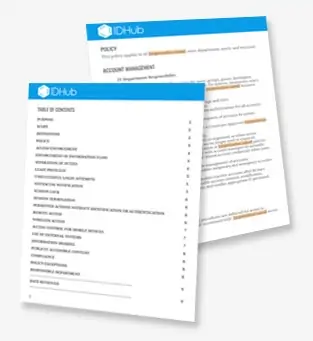
Access Control Policy Template
GET MY COPY
What Is An Access Control Policy?
A well-planned Access control policy details the framework of your information access security strategy.
Your IT department enforces these rules and guidelines to control the integrity of your information landscape.
This guide will help you create a policy that outlines the creation of roles and responsibilities for managing access control, along with procedures and protocols that help identify, classify, and protect sensitive information.
Understanding What Access Control Is
At its core, access control is the practice of limiting entry to your systems, networks, and physical spaces based on authenticated identities. An access control system—whether software-driven or hardware-based—evaluates credentials (like usernames, badges, certificates) and enforces your rules. By defining “who,” “what,” “when,” and “where,” you ensure only authorized actors can reach sensitive assets.
Common Access Control System Models
When designing your policy, it helps to know the major access control systems models:
Mandatory Access Control (MAC)
A rigid model where permissions are based on fixed labels (e.g., “Top Secret,” “Confidential”). The system enforces these rules centrally—you can’t override them.
Discretionary Access Control (DAC)
Resource owners decide who gets access, often via ACLs (access control lists).
Role-Based Access Control (RBAC)
Access is granted based on a user’s role in the organization.
Attribute-Based Access Control (ABAC)
Makes decisions on attributes (user, resource, environment) rather than roles.
6 Steps To Create A Thorough Access Control Policy.
1. Identifying the Objective of the Access Control Policy
It’s important to know what you’re trying to accomplish with your access control policy. It’s not just about establishing policies and procedures for the IT department, but also about identifying and protecting sensitive information and defining your authentication mechanisms.

Access control policies are split into two types: administrative policies and operational policies. The distinction between these two is that the former is meant to govern the IT department, while the latter focuses on network resources.
Once you know the objective of the access control policy, it’s important to identify what type of data is to be protected.
The types of data protected may also require you to consider any applicable laws and regulations. For example, storing private and confidential customer information will be subject to government policies.
Your organization may need to have specific protocols for managing things like; termination of employment, using mobile devices, Cybersecurity and AI concerns, inter-connectivity, or access granted to service providers.
It’s important to think about all these aspects to create a complete framework of rules and procedures to keep your business data safe.
2. Determining What Type of Data Needs to Be Protected
Access control policies are designed to protect data that is sensitive to the organization.
Typically, private and confidential information should not be disposed of or shared with any unauthorized individuals.
Before creating your access control policy, you need to determine what type of data needs to be protected and determine the level of sensitivity for each type.

The types of protection required for various pieces of information may vary.
If someone needs simple access to internal documents, the sensitivity level may be low, because an error would not cause any damage.
In contrast, if someone needs remote access to your private networks to modify public-facing data, your policy requirements would require a higher level of security.
Identifying what you’re protecting will help you identify which individuals or groups can have access to it, and what kind of tasks they are allowed to perform on this data.
Examples of data to be protected:
- HR information
- Customer information
- Financial information
- Intellectual property assets
- Credit card information
- Sensitive customer personal data
Once you identify the type of data that needs to be protected, you will usually create a list of acceptable authentication methods for each type and then assign one or more administrators for each department that handles the data.
3. Recognizing Which Individuals or Groups Need to Have Access
Once you’ve decided what data needs to be protected, you should identify which individuals or groups will have access to the data, as well as the specific permissions they need to use the information.
This step allows you to create common roles and responsibilities for managing parties with access based on the user access guidelines you will establish.
Examples:
- A business may need to protect data that contains trade secrets or information about individual employees. (e.g., managers).
- A government agency may need to protect certain data from outside parties and those with whom it has an agreement (e.g., its vendors).
- A healthcare organization may need to protect sensitive patient information.

In these cases, other individuals would not be allowed access unless they were approved by an Administrator.
Once you have identified which individuals or groups require access, you can then create a policy that outlines how minimum standard access is granted and revoked.
4. Identifying What Kind of Tasks Will Be Performed by These Individuals or Groups
In addition to who will have access, it’s important for you to know what kind of work will be performed by these individuals or groups and what the business requirements are.
The first step is to define the roles and responsibilities that the individuals or groups will have.
Types of roles and responsibilities for managing an access control policy:
- Access administrator: Responsible for granting or revoking appropriate user permissions.
- Account manager: Maintains user accounts and monitors password expiration.
- System manager: Oversees overall system security, day-to-day operations, monitoring, troubleshooting, and resolving security-related issues.
It’s important to keep in mind that each organization has different needs; some may require individual access (DAC), while others may adopt role-based access control RBAC or even ABAC.
Whatever you choose, document how these tasks are managed for your company. These responsibilities should include:
- Who has access to what resources
- How to monitor such access
- What data is allowed or not allowed on each resource
- When resources are available and when they’re unavailable
Once you’ve decided on these responsibilities, you’ll need to analyze how often they occur and document how access will be granted—whether through a 3rd-party IAM platform or a simple database or spreadsheet.
If you use an advanced Identity and Access Management system, decide if you’ll permit Manager-level permission control or limit user-management to your IT team.
5. Specifying the Level of Sensitivity of the Data Required for Each Task
It’s important to decide how sensitive the data is and how much protection it needs to prevent unauthorized access.
Working directly with the application owners you can develop your policy of least privilege to triage sensitive applications and resources in order to classify them according to your business needs.

The level of sensitivity of the data is one of the most important factors in creating data access rules.
The level of sensitivity changes how an administrator needs to approach the process and what type of security controls are necessary.
If you’re protecting confidential or personal information, you’ll want to ensure that employees have a high level of accountability for their actions.
However, if your company is just storing data that can be accessed by anyone on a network, you may not require as much security.
As you go through this guide, use these questions to determine what level of sensitivity your organization requires:
- Is there any sensitive information being stored?
- What type of data is it?
- Who has access to it?
- How frequently will it change?
6. Maintaining Regulatory and Government Access Compliance
As your organization develops its data protection policy, it's essential to ensure alignment with all applicable government and industry regulations. Compliance requirements vary by industry, but failing to meet them can lead to serious consequences, including audits, fines, and reputational damage.
To maintain proper regulatory compliance:
- Identify applicable laws and standards such as HIPAA, PCI-DSS, SOX, or GDPR that govern how data must be accessed, stored, and protected.
- Incorporate these legal requirements directly into your governance framework, including documentation for how access is granted, monitored, and revoked.
- Establish procedures for periodic audits and access certifications to validate that users only have the access they need and that excessive permissions are eliminated.
- Define disciplinary policies for misuse or unauthorized access in accordance with legal obligations.
- Monitor access activity regularly, keeping detailed logs to support future audits or investigations in the event of a security breach.
Ensuring compliance isn’t a one-time task—it’s an ongoing effort that must evolve with new regulations and threats. A well-structured data access policy helps protect sensitive data, reduces legal risks, and reinforces your organization's commitment to responsible data governance.
Using an Access Control Policy Template
Leverage an access management template to accelerate policy creation and ensure nothing critical is overlooked. A well-structured template serves as a starting point, guiding you through the essential components of an effective access protocol.
A robust template typically includes:
- Predefined sections for your policy objectives, scope, and role definitions
- Placeholders for implementing mandatory access control, role-based access control (RBAC), or other types of access control
- Fields for defining levels of access based on data sensitivity
- Guidelines for handling access requests, approvals, and regular access reviews
- Built-in prompts for documenting compliance requirements, audit procedures, and access governance measures
By aligning with the steps outlined above—such as identifying sensitive data, assigning roles, and complying with regulations—a policy template helps ensure your authorization model is both comprehensive and consistent. Simply populate it with your organization’s specifics and refine it to reflect your security strategy and operational needs.
How Identity and Access Management (IAM) Strengthens Access Control
Integrating an IAM solution into your security control policy enhances both security and operational efficiency. IAM platforms unify user identity, streamline workflows, and enforce consistent access control measures across applications and devices.
Key IAM Features That Improve Access Control
- Automated Provisioning & Deprovisioning
Ensures the right level of access is granted or removed automatically, reducing manual errors. - Streamlined Access Requests
Centralized portal for submitting, approving, and tracking all access requests. - Regular Access Reviews
Automates regular access reviews, highlighting stale or excessive permissions. - Access Certifications
Runs certification campaigns to comply with audit requirements. - Support for Multiple Access Control Models
Enables mandatory access control, RBAC, and ABAC within a single platform. - Audit Logging & Compliance Reporting
Captures every action for forensic analysis and regulatory evidence. - Delegated Administration
Allows team leads to manage their group’s access while IT retains oversight.
By leveraging these IAM capabilities, you reduce the threat of insider misuse, guard against external cyber threats, and reinforce your overall defense against a security breach.
Frequently Asked Questions: What Is An Access Control Policy?
Q: What is an access control policy?
A: It’s a documented set of rules, procedures, and roles that govern how access is granted, reviewed, and revoked in your organization.
Q: Why use an access control policy template?
A: A template speeds up policy creation, ensures you cover all critical sections (like scope, roles, and audit), and embeds best practices from day one.
Q: How does mandatory access control differ?
A: Under mandatory access control, permissions are strictly enforced by the system based on labels—users cannot override them, ensuring the highest security posture.
Q: How do IAM and regular access reviews reduce the risk of a security breach?
A: IAM automates provisioning and conducts periodic access reviews, ensuring permissions are always accurate and aligned with current business needs.
